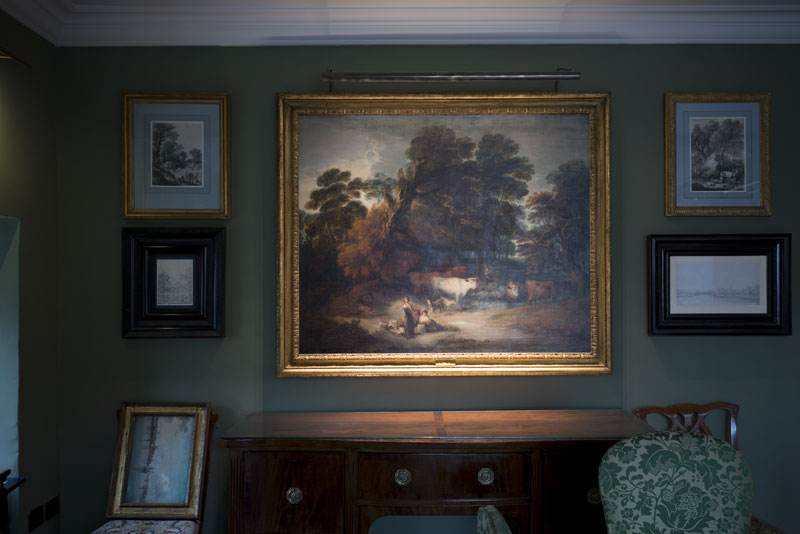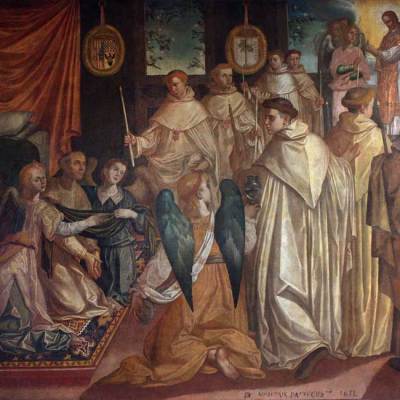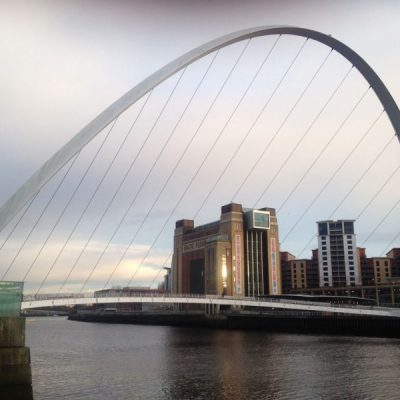This article was first published in the December 2014 issue of Apollo. Click here to subscribe to the magazine
Jonathan Ruffer’s impulse to collect has in recent years given rise to philanthropic pursuits. In 2010, he stepped in to secure an epic series of Zurbarán paintings at Auckland Castle – an act that proved the catalyst for an ambitious project that aims to regenerate a community
Writer Susan Moore
Photographs Jonty Wilde
I am by nature a collector,’ admits Jonathan Ruffer rather ruefully. ‘It is a pretty masculine disease. It’s basically a sign of weakness because it suggests that admiring, looking and appreciating is not enough. It demands possession of a thing. At the age of seven, it was stamps; at nine, vintage chocolate bar wrappers. Later my main focus was collecting old gramophone recordings of opera. Whatever the material, it is always a hat peg on the disease,’ he insists. ‘About 20 years ago I rather pulled myself together and decided that the whole business of collecting was not a very attractive way of spending a life because of this concentration on possession. So it is rather an odd thing – my life has been a series of unintended consequences – that I now have an important collection of 18th-century English landscapes and 17th-century Counter-Reformation paintings.’
It is not what one expects to hear from one of the City of London’s most successful fund managers, but then the reflective, highly articulate and, it transpires, witty Jonathan Ruffer is more old-school Oxbridge don than Wolf of Wall Street. On the Friday we meet, he resembles a bluff and amiable country gent, sporting tweed jacket, checked shirt and trousers of an extrovert red. The location is Auckland Castle, formerly the home to the Prince Bishops of Durham for more than 800 years (the current incumbent still retains an office here), and undoubtedly the most epic of Ruffer’s unintended consequences.
In 2010 he emerged as the white knight riding to the rescue of the castle’s extraordinary series of paintings of Jacob and his sons by Francisco de Zurbarán, after the Church Commissioners announced their intention to sell them to raise funds. Spanish Catholic Counter-Reformation images of Jacob and the founders of the 12 tribes of Israel are not what one might expect to find in an Anglican ecclesiastical palace. These arresting full-length portraits – in total there are 13 – had been acquired in 1756 by Bishop Richard Trevor, an advocate for Jewish emancipation, with the precise intention of reminding his guests of the common heritage of Christianity and Judaism. One, Benjamin, is an exact copy by Arthur Pond, commissioned by Trevor after he was outbid at auction.
The Twelve Tribes of Israel (1640–44), Francisco de Zurbarán’s (1598–1664) epic series of religious paintings, still hangs in the castle’s Long Dining Room.

When it became clear that what the Commissioners really wanted was to rid themselves of the castle – with the Zurbaráns in situ – Ruffer, with some misgivings, ended up taking its seven Grade I listed buildings and 800-acre estate on too. This proved a catalyst for the creation of the Auckland Castle Trust and a breathtakingly ambitious project that aims to regenerate this once rich but now deprived corner of the North East. It could be described as a leap of faith. In fact, art and faith play a central role.
When it was first revealed that his offer to give £15m to secure the Zurbaráns came sight unseen, the word on the street was that Ruffer, a committed Christian, had no interest in art. That, like many another art world rumour, turns out to be untrue. Indeed, one of Ruffer’s earliest acquisitions is critical to this story: an English 18th-century copy of what appears to be a Zurbarán St Francis. ‘When the news broke about [the selling of] the Auckland Castle pictures, one of the first things I thought was how absolutely unknown Zurbarán was in England in the 18th century, and that I had possibly the only other iteration of – what shall we call it? – English 18th-century “Zurbanity”. That superficial connection triggered the idea that if anybody was going to rescue these pictures from going abroad, I was in a financial position to do it.’
Earlier that year, Ruffer had announced his intention to take a back seat in his company. Born near Middlesbrough, he initially intended to return to the North East for a couple of days a week, to give something back to the community. ‘I had thought I would be coming up here with a soup ladle and working on the coalface in South Shields,’ he laughs, ‘but somebody said, “Marvellous – what qualities do you bring to that?” And the answer is bugger all. When I thought about it, I realised that I could be a force for unity up here. It seemed to me that what the Church Commissioners were doing was deeply disuniting, so saving the Zurbaráns exactly fitted the bill.
‘If I was going to make a provocative remark in this interview,’ he continues, obviously relishing the prospect, ‘it is that I deliberately took on what seems to me the dishonesty of Antony Gormley’s Angel of the North [1998]. In this part of the world there is a sense that lovely things are never brought up here or, if they are, they are then taken away.’ Velázquez’s celebrated nude known as ‘The Rokeby Venus’ (1647–51), for instance, left nearby Rokeby Park for London’s National Gallery in back in 1906. ‘One of the dynamics that made me feel that this project might be worthwhile is the way that people here feel that they own the Angel of the North. They treat it like an Old Testament Ashterof. They go there with a heavy heart because their nan is ill, leave a bunch of daffs, and go away encouraged. That is exactly what paganism is. The name of the sculpture is taken from Christian language, the form is that of the Crucifixion, and yet the role it plays up here is entirely pagan.
‘The Zurbaráns make you smile, and they unsettle you,’ he continues. ‘This sense of Melchizedek, “without beginning, without end”, is a key part of their power. I thought that if in decades to come people can associate them with their deeply religious and humanitarian origins – humanitarian in the way that they came to be here – and see them as being part of their heritage, that would be altogether a more uplifting thing than what is essentially a falsity at Gateshead.’
He had acquired his first ‘proper’ picture about 15 years ago when a dealer friend, knowing he loved opera, offered him a portrait of the singer Mrs Crouch. ‘I thought it was a terrific thing, and it turned out to be a Romney.’ When I ask him how he alighted on 18th-century English landscapes and Counter-Reformation painting, he reveals that the same dealer had suggested it when Ruffer and his wife, Jane, found themselves with ‘quite a large house and no pictures at all’. I venture to suggest that this sounds rather arbitrary. ‘As I said, collecting is a hat peg, and it is quite false to believe that you have the power of deciding what you are going to be interested in. I think that appreciation is a response, and collecting merely an extension of appreciation.’
A hallway is devoted to Richard Wilson. There is a fine pair of Italianate views from 1765, Diana and Callisto, Lake Nemi and Rome from the Villa Madama, formerly in the Sir George Leon collection, alongside a view of Maecenas’ villa in Tivoli (1754). Nestling between them is a Wilson copy by his pupil William Hodges.
Forest Landscape with Milk Maids (1783), Thomas Gainsborough (1727–88) Oil on canvas, 44 x 172cm. Private collection

Thomas Gainsborough – early and late – steals the show in the Ruffers’ private dining room. Presiding over all is Forest Landscape with Milk Maids (1783), a late bucolic pastoral of cattle and figures. ‘It is almost the best thing he ever did,’ Ruffer muses. ‘I think the composition is better than that of The Watering Place in the National Gallery.’ Another wall bears the sublime Dolbadarn Castle, Llanberis (1763), the early morning mists dissolving to reveal the stark and lonely Welsh mountains, painted by the greatest of 18th-century Irish painters, George Barret Sr. Beside it hangs the winner of the first ‘premium’ awarded by the Society of Artists in 1760, a refined Arcadian landscape by George Smith of Chichester. For company, they have other landscapes by Constable, Reinagle and, unusually, Reynolds.
If forced to choose between his two collections, the Counter-Reformation paintings would win hands down. Never drawn towards Dutch or German schools, with the honourable exception of Rembrandt, his focus is Italy, Spain and France. ‘I am pretty God-y,’ he begins, ‘and it seemed to me an interesting period to collect. Why was the Reformation so powerful? The answer is that the idea that God reveals himself through the Word becomes a much more universal and democratic thing when you have got the printing press. The idea that the written word could actually be unmediated by priests was deeply threatening to the established church. In the late 1560s, the Council of Trent decreed that art could communicate God directly to the viewer, and the purpose of that was to provide painting that was theologically acceptable. It took the artistic community about 50 years to respond, and it is extraordinary how almost all the great religious pictures of the century were painted in the 30-year period between 1620 and 1650. Our Zurbaráns fall exactly in the middle of that.’ He continues: ‘From the 1650s onwards, it was réchauffage. Although some later painters can be marvellous, generally speaking, the power had gone. Descent from the Cross here is a wonderful painting, but you can sense that the artist is second time round.’
Descent from the Cross (After 1679), Circle of Charles Le Brun, attributed to François Verdier (1651–1730)
Oil on copper, 117 x 84 cm. Zurbarán Trust

Attributed to François Verdier, this large and luscious oil on copper of around 1679, still in its original royal frame, is among the Ruffer pictures currently hanging in the public rooms of the castle. Alongside it is a serene and classical St Agnes painted in Rome around 1640 and attributed to Poussin’s nephew and pupil Pierre Letellier, an artist little known outside Rouen. Ruffer is not hung up on names. ‘I think The Dead Christ here is one of our best pictures but we have no idea who did it [1625–30]. It is an astonishing piece,’ he pronounces, gazing up at it. Larger tours de force include a St Catherine of Alexandria of around 1625 by Giovanni Bilivert, and Ottavio Vannini’s Susannah at the Fountain, commissioned around 1625–30 by the senator Giulio Pucci and acquired from the family. ‘One careful lady driver. Big. Terrifically out of fashion,’ beams their owner. Like the Neapolitan school Lot and his Daughters of around 1630–40, they are hung high on staircases and fiendishly difficult to see.
Our last temporary gallery is the castle Music Room, currently playing host to most of Ruffer’s Spanish paintings. His favourite among a group of half-length – and half-clad – aged saints with sagging flesh, either by or after Jusepe de Ribera, is a St Andrew of around 1619, a version of the painting in the Quadreria dei Girolamini in Naples.
‘Is anyone gasping in astonishment at these pictures?’ he breezily asks one of the castle guides. ‘They are trying hard to appreciate them,’ came her careful response, ‘but someone did say that they looked like granddad in the bath.’
St Andrew (c. 1619), attributed to Jusepe de Ribera, (1591–1652) Oil on canvas, 144 x 117cm. Private collection

Ruffer is continuing to expand the Spanish collection in order to contextualise the Zurbaráns, for part of the Trust’s plan is to make this small corner of England forever Spain. It began when Jacob Rothschild told him that by securing the Zurbaráns he had unlocked the door to an intractable problem, and if he stopped there, he would simply fail. Wouldn’t it make sense to take on the castle and use that to regenerate this part of the world? Ruffer was wary. ‘I have always been frightened by bricks-and-mortar heritage. These places are implacable mistresses.’
He deferred to the opinion of another heritage sage, Neil MacGregor. His response was that this was an exceptional way of harnessing the power of art to a community. ‘And so I went for it. I realised that we have got to make this place a destination. We can’t rely on the locals as they don’t have the money. What happens here has to be astonishing, and it has to be more than one exhibition. We are going hammer and tongs to make the offering here of international standing. If it isn’t, there is no point. That is the challenge.
‘My way of looking at it was that the castle is clearly an important place and it is quite grand, but it is also quite small in the way of medieval places. Everything, including the 17th-century walled garden currently being restored, is essentially a room. Where could we put a gallery and exhibition space?’ The answer, ironically, was to dig deep, raise funds, and build – or buy – even more bricks and mortar. A new wing designed to house a permanent exhibition entitled ‘5,000 Years of Faith’ is scheduled to open in 2018. ‘We will be plundering the national institutions,’ Ruffer grins. ‘So much great material is not on show, and that gives us a chance to say something of importance here.’
A brisk walk to the market square of Bishop Auckland, minutes from the castle gate, reveals the ornate Venetian Gothic former bank that will be converted into three high-ceilinged galleries that, Ruffer hopes, will also be the recipient of long-term loans from the Prado in Madrid (Ruffer is a trustee), after it opens in 2017. Next to it, the old schoolhouse, courtesy of Banco Santander, will house a research institute devoted to Spanish art, run in association with Durham University which has recently set up a Centre for Visual Arts and Culture.
‘Given the Spanish pictures here and at the nearby Bowes Museum in Barnard Castle, this is a perfect place to teach the Spanish Golden Age,’ Ruffer enthuses. ‘What the Bowes has is the top end of national talent rather than international talent – although they do have Goya and El Greco. Its strength is that if you want to know what was going on with Spanish art at the time it is almost the best place to see it, because at the Prado you are only looking at masterpieces.’ It was the Prado’s deputy director Gabriele Finaldi who suggested the recent symposium on Spanish art in the region here, organised in association with the Bowes and Durham University.
Finally, we take a quick look at the two inns that the trust has also acquired to transform into a hotel for visitors to the gallery, castle and – wait for it – the historical leisure park planned beneath it. Inspired by the hugely successful Puy du Fou in France, its first phase will be a series of spectacular re-enactments of Viking invasions, Roman gladiatorial combats and the like.
Ruffer once described Auckland Castle as a Dulcinea, the lady who inspired Don Quixote to noble deeds. This great but not completely funded venture requires more than one white knight. Some £5.5m of the £55m project is still required.
Click here to buy the latest issue of Apollo
Related Articles:
Auckland Castle’s plan to revive religious art (Emma Crichton-Miller)
County Durham celebrates its Spanish heritage (Chris Ferguson)
Small Wonders: The Bowes Museum (Adrian Jenkins)





